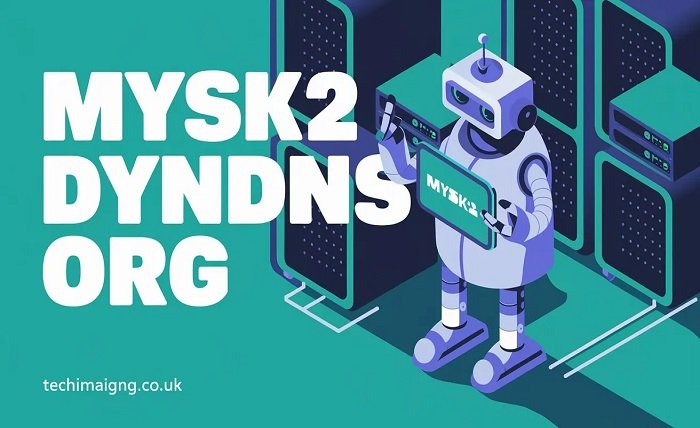Everything You Need to Know About Mysk2 DynDNS: A Complete Guide

Introduction
In the fast-paced digital world, maintaining a stable network is crucial, especially when it comes to remote access or hosting services. One essential tool in this regard is Dynamic DNS (DynDNS). Among the various DynDNS providers, Mysk2 DynDNS has emerged as a popular choice for users seeking reliable remote access to their network devices. This guide will walk you through everything you need to know about Mysk2 DynDNS, including its features, setup process, troubleshooting tips, and much more.
What is Mysk2 DynDNS?
mysk2 DynDNS is a dynamic domain name system service that allows users to access their home or office networks remotely using a domain name. Traditionally, Internet Service Providers (ISPs) assign dynamic IP addresses to their customers, which can change periodically. This presents a challenge for users who want to remotely connect to their devices, as the changing IP addresses can make it difficult to find their network consistently.
By using Mysk2 DynDNS, you can set up a hostname that stays consistent, even if your IP address changes. This makes it easier to access your devices, whether it’s for accessing surveillance cameras, managing servers, or remotely controlling smart devices. With Mysk2 DynDNS, you won’t need to worry about IP address changes again.
How Does Mysk2 DynDNS Work?
At its core, Mysk2 DynDNS works by automatically updating your domain name with your device’s current IP address. Here’s a breakdown of how it functions:
- DNS Lookup: When you attempt to connect to your device using the provided hostname, a DNS query is made to resolve the domain name to an IP address.
- Dynamic IP Update: If your IP address has changed since the last query, Mysk2 DynDNS will automatically update the DNS records to point to the new IP address.
- Reliable Remote Access: Once the update is complete, you can access your devices remotely without worrying about IP address changes. The system ensures that your hostname always resolves to your current IP.
The dynamic nature of the DNS update is crucial for users with dynamic IP addresses. Without Mysk2 DynDNS, you would have to manually track and update the IP address whenever it changes.
Key Features of Mysk2 DynDNS
One of the reasons Mysk2 DynDNS has become a popular choice is its robust set of features. Some of the most notable features include:
- Ease of Use: The service offers an easy-to-use interface, making it accessible for both beginners and advanced users.
- Automatic IP Updates: As mentioned earlier, Mysk2 DynDNS automatically updates the DNS records, eliminating the need for manual intervention.
- Multiple Hostnames: Users can set up multiple hostnames for different devices or services on their network.
- Custom DNS Settings: For advanced users, Mysk2 DynDNS provides the option to customize DNS settings for more control over network traffic.
- Reliability and Speed: Mysk2 DynDNS is known for its reliable performance and fast DNS propagation, ensuring minimal downtime.
These features make Mysk2 DynDNS an excellent choice for users who require seamless remote access and enhanced network management.
How to Set Up Mysk2 DynDNS
Setting up Mysk2 DynDNS is a straightforward process. Follow these steps to get started:
- Create an Account: Visit the Mysk2 DynDNS website and create an account by providing basic information, including your email address.
- Choose a Hostname: After logging in, select a hostname for your network. This will be the address you use to access your network remotely (e.g., mynetwork.mysk2.com).
- Configure Your Router or Device: Log in to your router or network device’s administration panel. Locate the Dynamic DNS settings and enter the hostname and credentials you received from Mysk2 DynDNS.
- Test the Setup: Once everything is configured, test your connection by entering the hostname in a web browser or remote access tool. You should be able to access your network remotely.
The process may vary slightly depending on your router or device, but Mysk2 DynDNS provides clear instructions for different models.
Troubleshooting Common Mysk2 DynDNS Issues
While Mysk2 DynDNS is reliable, like any service, issues can arise from time to time. Here are some common problems and how to troubleshoot them:
- Failed DNS Update: If your hostname isn’t resolving to the correct IP address, check that your router or device is correctly configured with your Mysk2 DynDNS credentials. Ensure that your router’s firmware is up-to-date as well.
- Hostname Not Resolving: If you can’t access your network using the hostname, check your DNS settings. Sometimes, it may take a few minutes for changes to propagate.
- IP Address Conflicts: If you’re using multiple devices with Mysk2 DynDNS, make sure each device has a unique hostname and is correctly assigned to the corresponding IP address.
In most cases, following the troubleshooting steps on the mysk2 DynDNS support page will help resolve any issues you encounter. Additionally, contacting customer support can be a useful option if the issue persists.
Benefits of Using Mysk2 DynDNS for Your Network
There are many benefits to using Mysk2 DynDNS for your home or office network. Some of the key advantages include:
- Access from Anywhere: Whether you’re at home, at work, or traveling, you can always connect to your devices using the hostname provided by Mysk2 DynDNS.
- Enhanced Security: By using Mysk2 DynDNS, you can implement stronger security measures, such as VPNs or firewalls, to protect your network while still having remote access.
- Cost-Effective: Compared to other remote access solutions, Mysk2 DynDNS is often more affordable, especially for individuals and small businesses.
- Improved Network Control: With Mysk2 DynDNS, you gain more control over your network, including the ability to set up port forwarding, manage multiple devices, and monitor activity remotely.
In short, Mysk2 DynDNS offers a range of benefits for users seeking a reliable and affordable solution for remote access.
Mysk2 DynDNS vs. Other Dynamic DNS Providers
There are several other Dynamic DNS providers in the market, but what sets Mysk2 DynDNS apart from the competition? Let’s compare it with some of the most popular options:
- Mysk2 DynDNS vs. No-IP: While No-IP offers a free plan, Mysk2 DynDNS provides more advanced features like custom DNS settings and faster updates. Additionally, Mysk2 DynDNS has a more user-friendly interface.
- Mysk2 DynDNS vs. Dyn: Dyn is a premium service with robust features, but it comes at a higher cost. For users who need basic DynDNS functionality, Mysk2 DynDNS offers a more affordable solution.
- Mysk2 DynDNS vs. DuckDNS: DuckDNS is another free option, but it lacks the customization options and support that Mysk2 DynDNS provides.
Ultimately, Mysk2 DynDNS offers a well-rounded, cost-effective solution for users who want a balance of features and affordability.
Conclusion
In conclusion, Mysk2 DynDNS is an excellent tool for anyone needing reliable and consistent remote access to their network. With its easy setup, powerful features, and troubleshooting support, it’s a top choice for home and business users alike. By using Mysk2 DynDNS, you can enjoy hassle-free access to your devices and greater control over your network. Whether you’re a tech enthusiast, a small business owner, or someone simply seeking to access their network remotely, Mysk2 DynDNS is worth considering.
FAQs
1. What is the purpose of Mysk2 DynDNS?
Mysk2 DynDNS allows users with dynamic IP addresses to access their network devices remotely using a consistent hostname, even when their IP address changes.
2. Is Mysk2 DynDNS free?
While Mysk2 DynDNS offers both free and paid plans, the free plan may have limitations on features and the number of hostnames. The paid plans provide more advanced functionalities.
3. How do I set up Mysk2 DynDNS on my router?
To set up Mysk2 DynDNS on your router, log in to the router’s administration panel, locate the Dynamic DNS settings, and enter the hostname and credentials provided by Mysk2 DynDNS.
4. Can I use Mysk2 DynDNS with multiple devices?
Yes, Mysk2 DynDNS allows users to set up multiple hostnames for different devices, enabling remote access to each one individually.
5. What should I do if Mysk2 DynDNS is not working?
If you experience issues with Mysk2 DynDNS, check your configuration settings, ensure that your router’s firmware is updated, and refer to the troubleshooting section on the Mysk2 DynDNS website.




